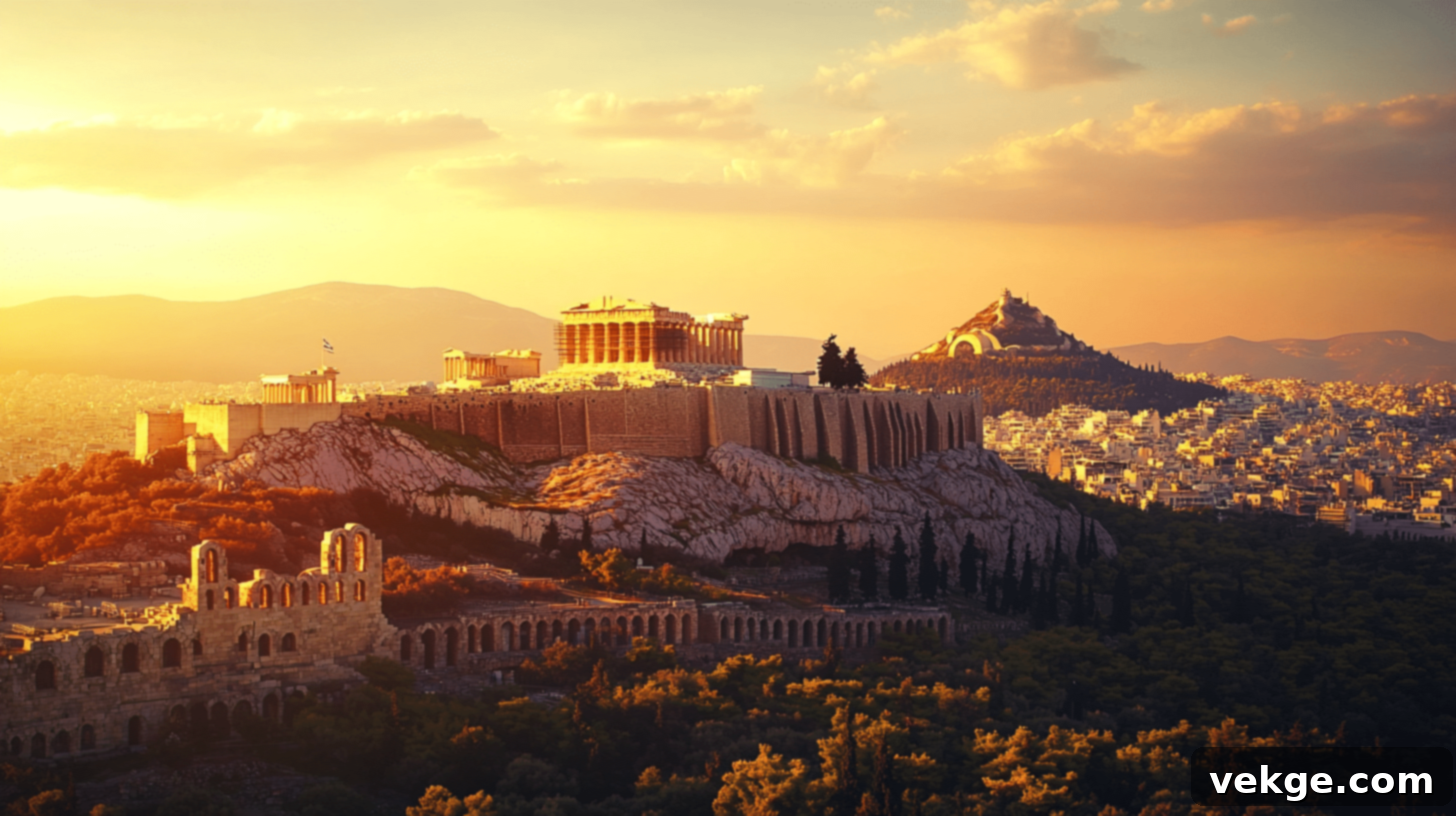Explore the Enduring Majesty of Ancient Greek Architecture: Iconic Buildings & Timeless Designs
Close your eyes and imagine this: you’re standing before the Parthenon, its golden-white marble glowing warmly under the gentle afternoon sun. This isn’t merely an ancient ruin; it’s a 2,500-year-old masterpiece that continues to captivate and inspire visitors from around the globe. Built meticulously by hand, long before the advent of modern tools or machinery, the Parthenon stands as a profound testament to how ancient Greeks masterfully blended perfect mathematical principles with breathtaking artistic vision to create something truly timeless and enduring.
Every precisely carved column, every intricate frieze, and every grand archway narrates a compelling story. These tales speak of powerful gods and goddesses, legendary heroes, and the brilliant minds who engineered these wonders. From the spiritual significance embedded in their sanctuaries to the practical elegance of their public spaces, Greek architecture offers a window into a civilization that shaped much of Western thought and design.
In this comprehensive guide, we will journey through both the most famous landmarks that define Greece’s architectural legacy and uncover some of its lesser-known, yet equally fascinating, surprises. You’ll delve into the ingenious methods clever builders employed to design temples that seem to defy optical laws, explore serene ruins where history feels vibrantly alive, and discover how today’s architects still draw inspiration from these ancient, groundbreaking ideas. Prepare to be amazed by the sheer ingenuity and lasting beauty of Greek architectural heritage.
Iconic Ancient Greek Buildings: Masterpieces of Classical Design
Ancient Greek architecture represents a veritable golden age of design, where unparalleled mathematical precision converged with exceptional artistic brilliance. These pioneering builders achieved a perfect, harmonious balance between practical needs and aesthetic beauty, employing meticulous measurements and subtle optical tricks to ensure their structures appeared perfectly straight and flawlessly balanced to the human eye. They possessed an intuitive understanding of visual perception, adjusting their designs so that columns which appear perfectly vertical were, in fact, subtly curved (entasis), creating an illusion of strength and dynamism. This extraordinary attention to both rigorous mathematics and profound art resulted in buildings that continue to inspire awe and admiration today, serving as powerful examples of how technical skill and creative vision can unite to forge something truly lasting and impactful.
1. The Parthenon: A Symbol of Athenian Glory
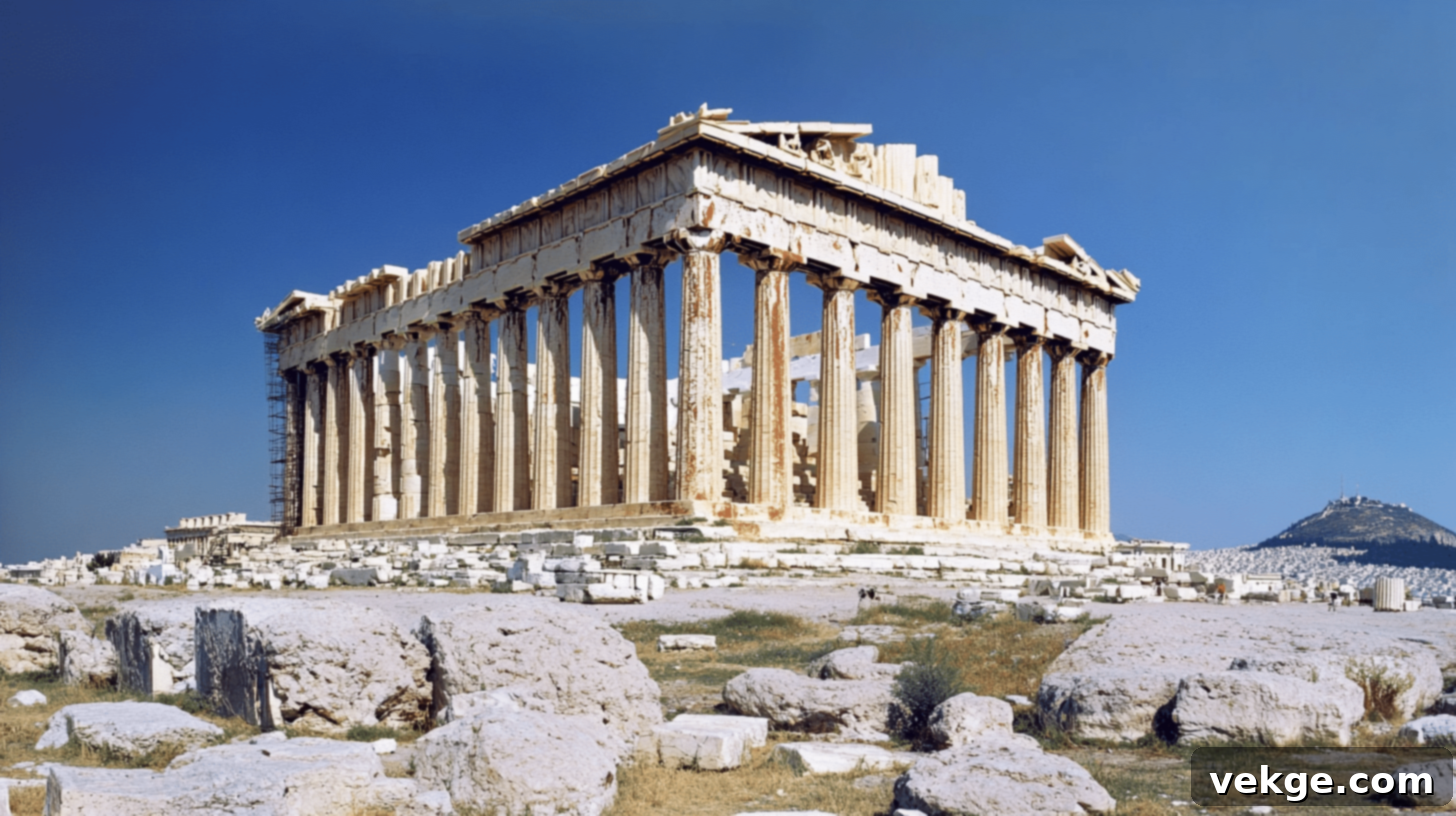
Perched majestically atop the Acropolis in Athens, the Parthenon remains an unparalleled masterpiece of architectural perfection. Constructed between 447 and 432 BCE, this Doric temple, dedicated to the goddess Athena Parthenos, exemplifies mathematical precision in every single line, angle, and proportion. Its rich and complex history spans multiple eras, evolving from a vibrant religious temple to a Christian church and later a mosque during Ottoman rule. This remarkable adaptability and continued use throughout centuries underscore the building’s profound significance, extending far beyond its original sacred purpose, making it a universal symbol of classical antiquity and human achievement.
2. The Temple of Olympian Zeus: A Monument to Grandeur
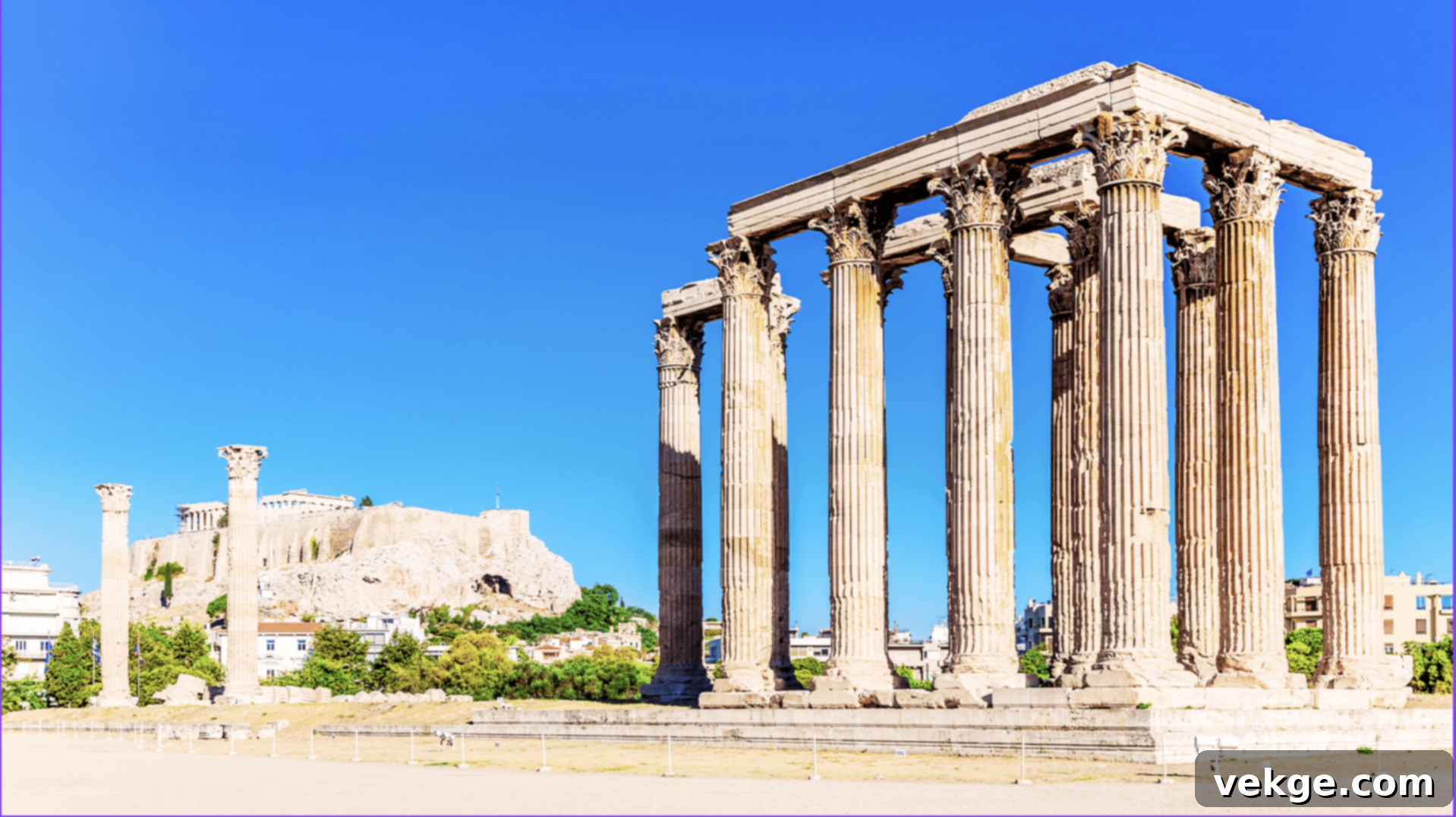
A monument of truly extraordinary scale, the Temple of Olympian Zeus stands as a testament to the unparalleled grandeur of Greek religious architecture. Its construction was initiated in the 6th century BCE but only finally completed nearly 650 years later by the Roman Emperor Hadrian. While only 15 of its original 104 massive Corinthian columns still stand today, their immense presence continues to inspire awe, offering a vivid glimpse into the ambitious scale and artistic vision of its creators and successive patrons. This temple was meant to be the largest in Greece, a truly colossal dedication to the king of the gods.
3. The Erechtheion: A Study in Unique Elegance
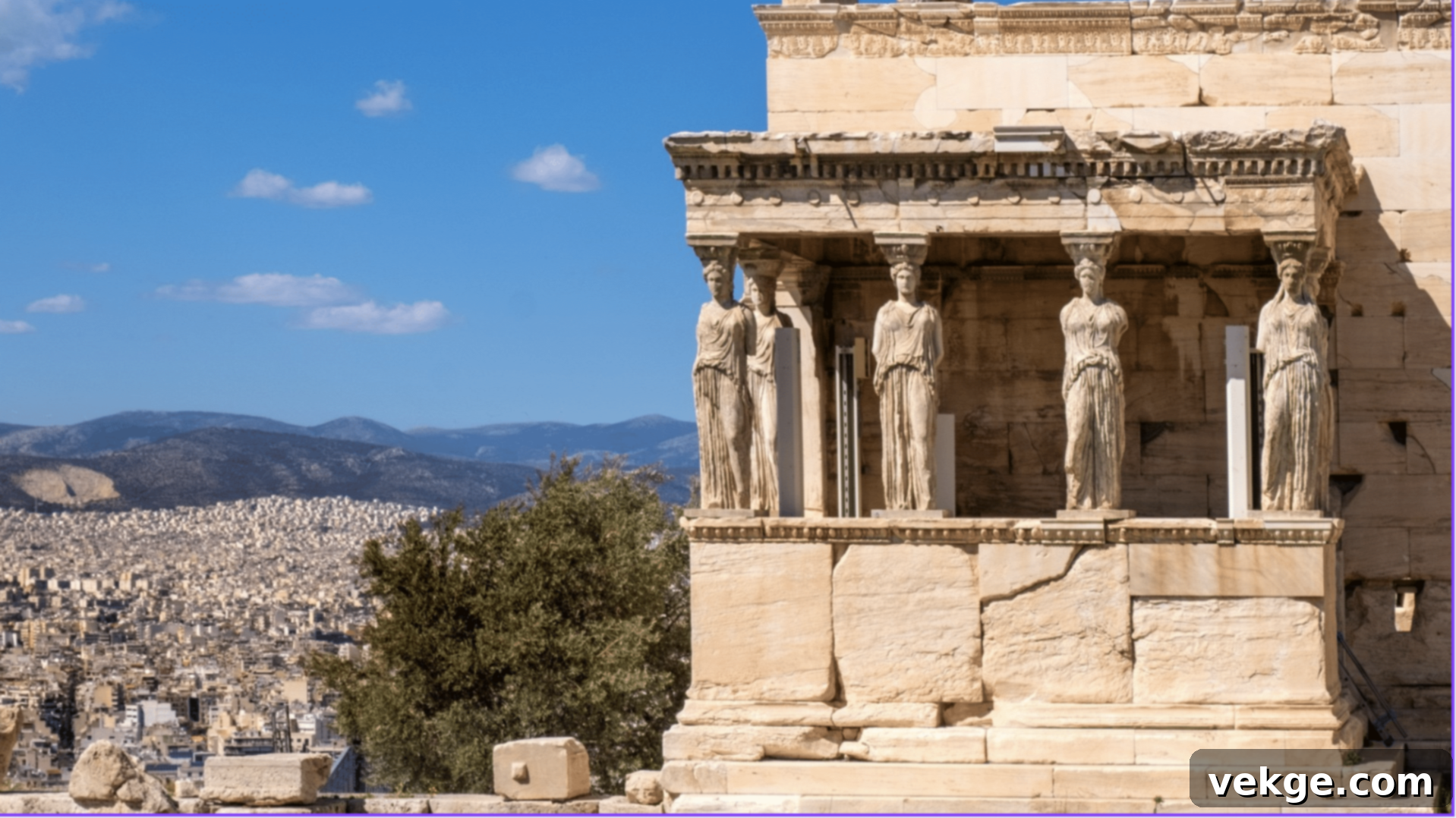
Also situated on the sacred ground of the Acropolis, the Erechtheion captivates with its uniquely complex and asymmetrical design, setting it apart from other classical temples. Its most renowned feature is undoubtedly the Porch of the Caryatids, where six graceful female statues stand as architectural supports, replacing traditional columns. These exquisitely sculpted figures not only serve a structural purpose but also create a distinctive architectural statement, a poetic defiance of conventional design that showcases the sophisticated artistry and innovative spirit of ancient Greek architects.
4. The Theatre of Epidaurus: Acoustic Perfection Personified

More than just a building, the Theatre of Epidaurus represents cultural expression at its absolute finest. Constructed in the 4th century BCE, this magnificent open-air theatre boasts truly exceptional acoustics—a mere whisper on the stage can be heard with astonishing clarity in the highest rows, a profound testament to the ancient Greeks’ sophisticated understanding of sound propagation and spatial engineering. Nestled within a natural hollow, its design maximized both visibility and auditory experience for an audience of up to 14,000 spectators, making every dramatic performance a collective and immersive experience.
5. The Temple of Apollo at Delphi: Oracle and Sanctuary
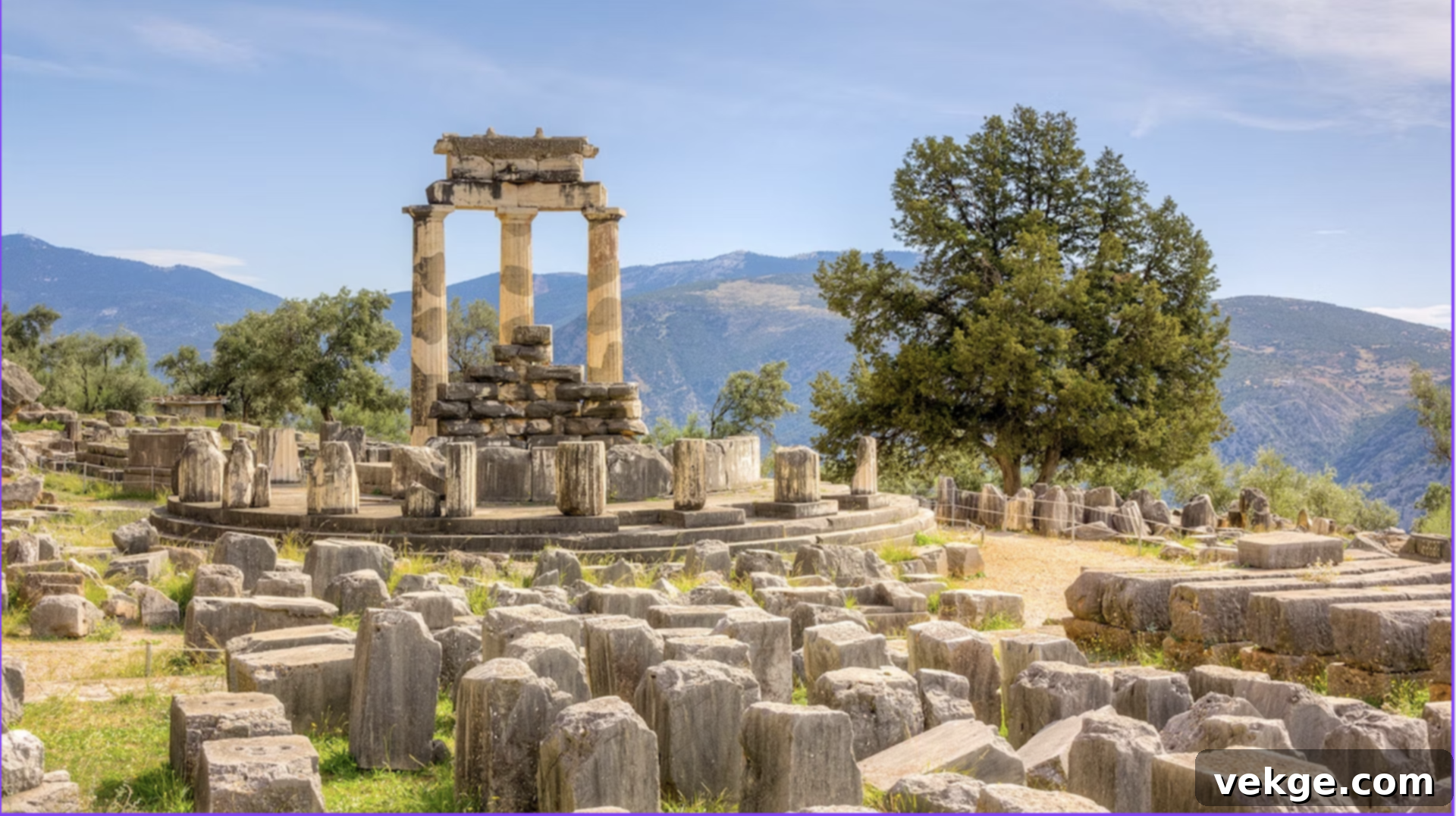
Nestled dramatically on the slopes of Mount Parnassus, the Temple of Apollo at Delphi was a critically important pan-Hellenic religious center, revered across the ancient Greek world. As the hallowed home of the famous Oracle, it powerfully demonstrates how Greek architecture seamlessly integrated deep spiritual significance with thoughtful physical design. Its strategic, awe-inspiring location reflects the profound connection ancient Greeks perceived between human-made structures and the surrounding natural landscapes, creating a sanctuary that was both sacred and harmoniously integrated with its environment.
Lesser-Known Greek Buildings with Rich Histories: Hidden Gems of Antiquity
Beyond the universally famous landmarks, Greece is replete with numerous architectural gems that reveal the profound depth and diversity of ancient Greek building techniques and cultural practices. These often-overlooked treasures – from small countryside temples and ingenious ancient water systems to remote sanctuaries nestled in tranquil landscapes – frequently tell more intimate and nuanced stories about daily Greek life, their engineering prowess, and religious beliefs than their more famous counterparts. With fewer crowds, these sites offer visitors a unique opportunity to experience history up close and personal, allowing for the discovery of subtle details like ancient mason’s marks etched into stones or worn steps that bear witness to centuries of human activity. These overlooked masterpieces unequivocally prove that Greek architectural brilliance extended far beyond the well-known sites, permeating every corner of their vibrant world.
6. The Stoa of Attalos: A Hub of Ancient Athenian Life
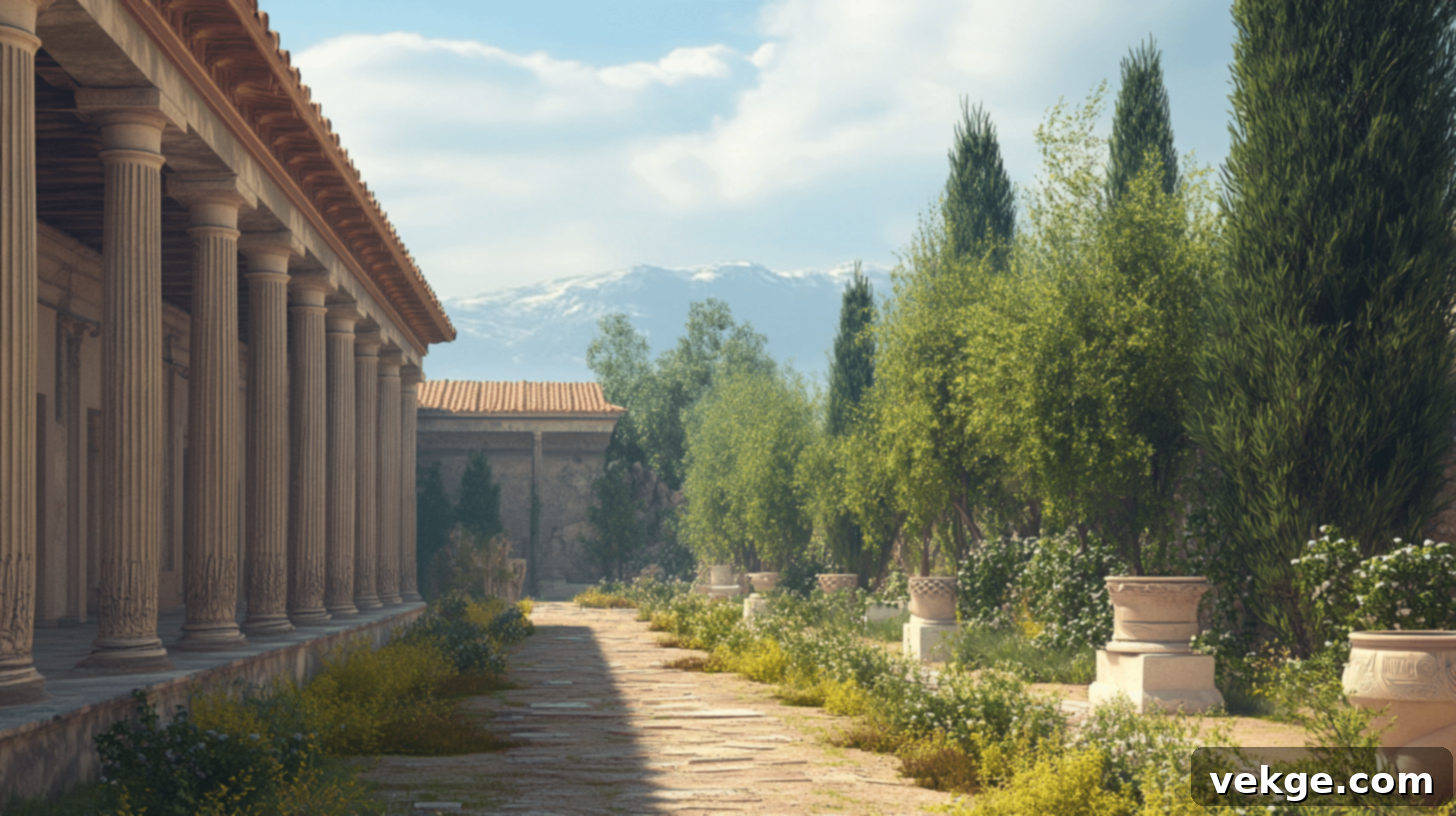
Once a bustling, long, and covered walkway in ancient Athens, the Stoa of Attalos served as a vibrant commercial and public meeting place, housing numerous shops and stalls where merchants plied their trades and citizens gathered to discuss politics and philosophy. Today, following an impressive reconstruction in the 1950s using the same materials and methods as the original, it serves as a museum, showcasing artifacts from the daily life of ancient Greece. The building features two floors adorned with columns of both Doric and Ionic orders, offering a tangible sense of what ancient Athenian civic life truly entailed.
7. The Temple of Aphaia: Celestial Alignments on Aegina

This exquisite temple, situated on a hill on the island of Aegina, offers breathtaking views of the surrounding sea. What makes the Temple of Aphaia particularly special is its precise astronomical alignment with the sun during specific times of the year, especially during the equinoxes. The ancient builders meticulously positioned the temple to correspond with natural celestial events, powerfully illustrating how ancient Greeks skillfully combined advanced building techniques with their profound knowledge of the stars and their religious observances. It stands as a beautiful example of early Doric architecture transitioning towards the Classical style.
8. Temple of Hephaestus: Athens’ Best-Preserved Temple
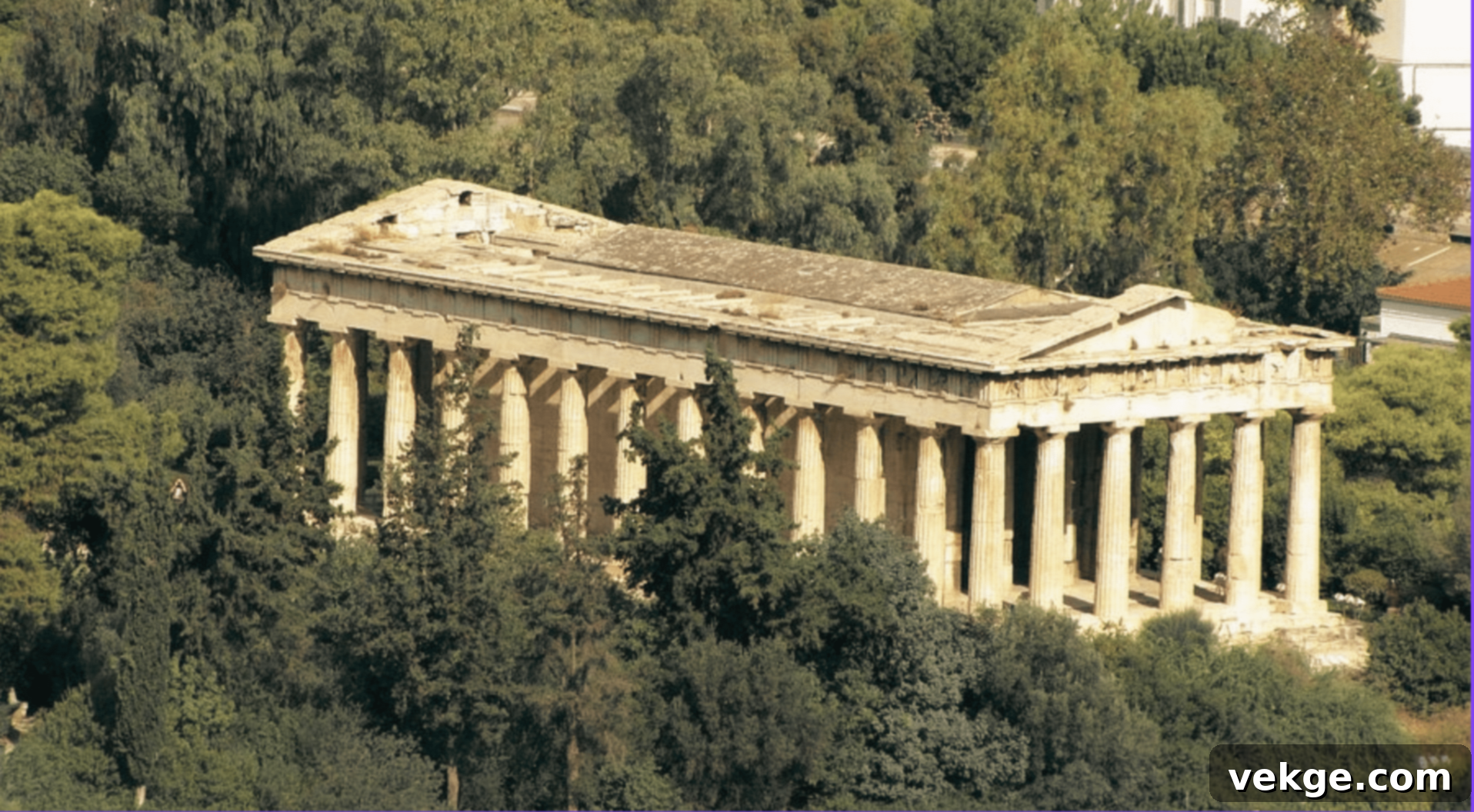
Often overshadowed by the Parthenon, the Temple of Hephaestus in the Ancient Agora of Athens is remarkably well-preserved, standing almost entirely intact after more than 2,400 years. Built to honor Hephaestus, the god of metalwork, craftsmanship, and fire, it features robust Doric columns and intricate sculptural decorations depicting the labors of Heracles and Theseus. Its exceptional state of preservation is largely attributed to its continuous use as a Christian church for many centuries, which protected it from the extensive damage suffered by many other ancient sites. It offers an unparalleled look at a complete Doric temple.
9. Sanctuary of Artemis Gorgo: Early Doric Splendor
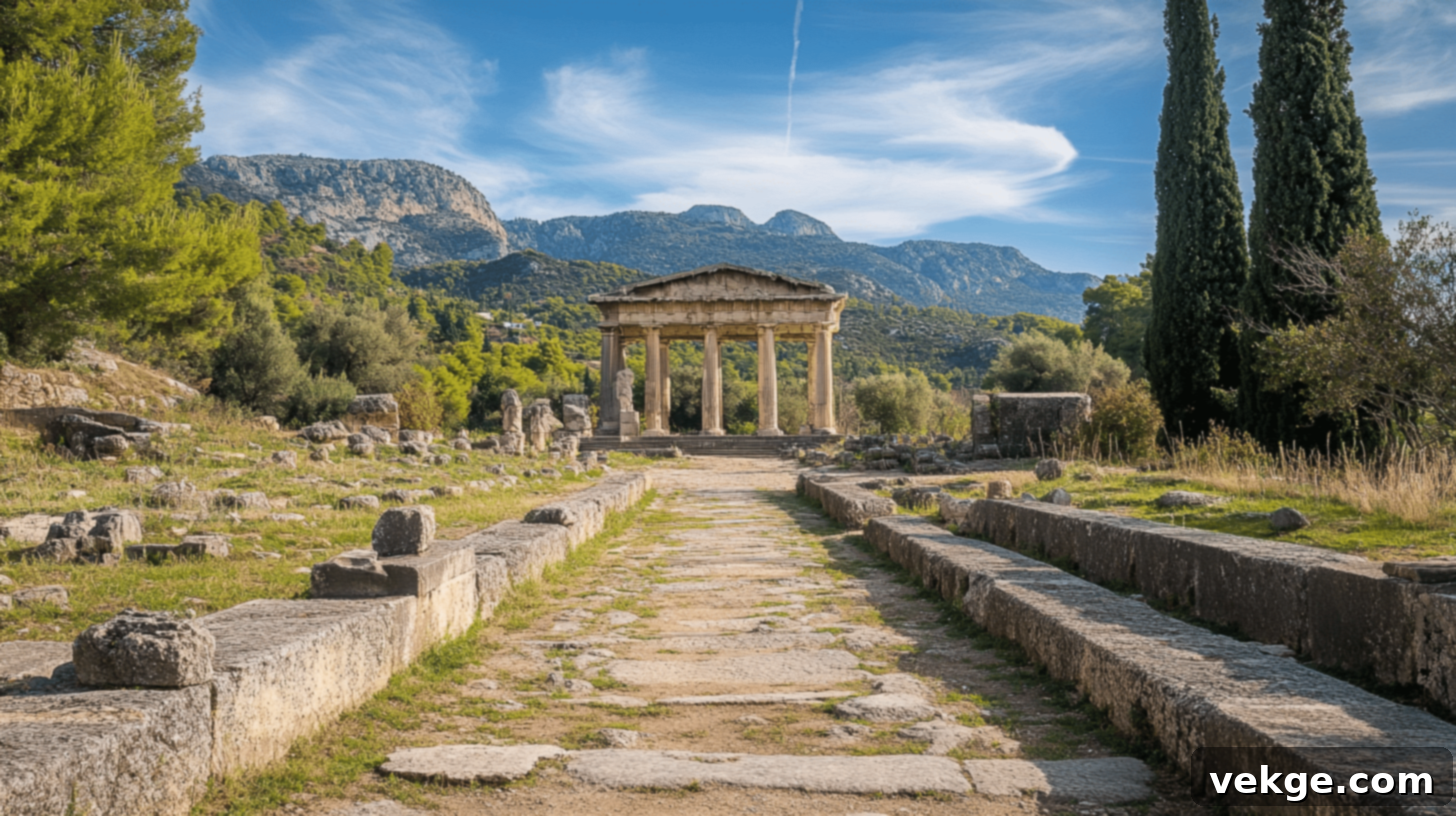
This early temple, located in Corfu, showcases some of the earliest and most monumental uses of the Doric style in Greek architecture. Its remaining walls and pediments feature powerful and often terrifying carvings of mythological monsters and heroes from Greek stories, including the fearsome Gorgon Medusa. The temple was built to honor Artemis, the goddess of hunting, wilderness, and the moon, and its distinctive artwork powerfully demonstrates the importance of these chthonic deities and local cults to the people of ancient Greece, reflecting a raw, archaic power in its design and decoration.
10. Temple of Hera at Olympia: A Glimpse into Early Greek Building
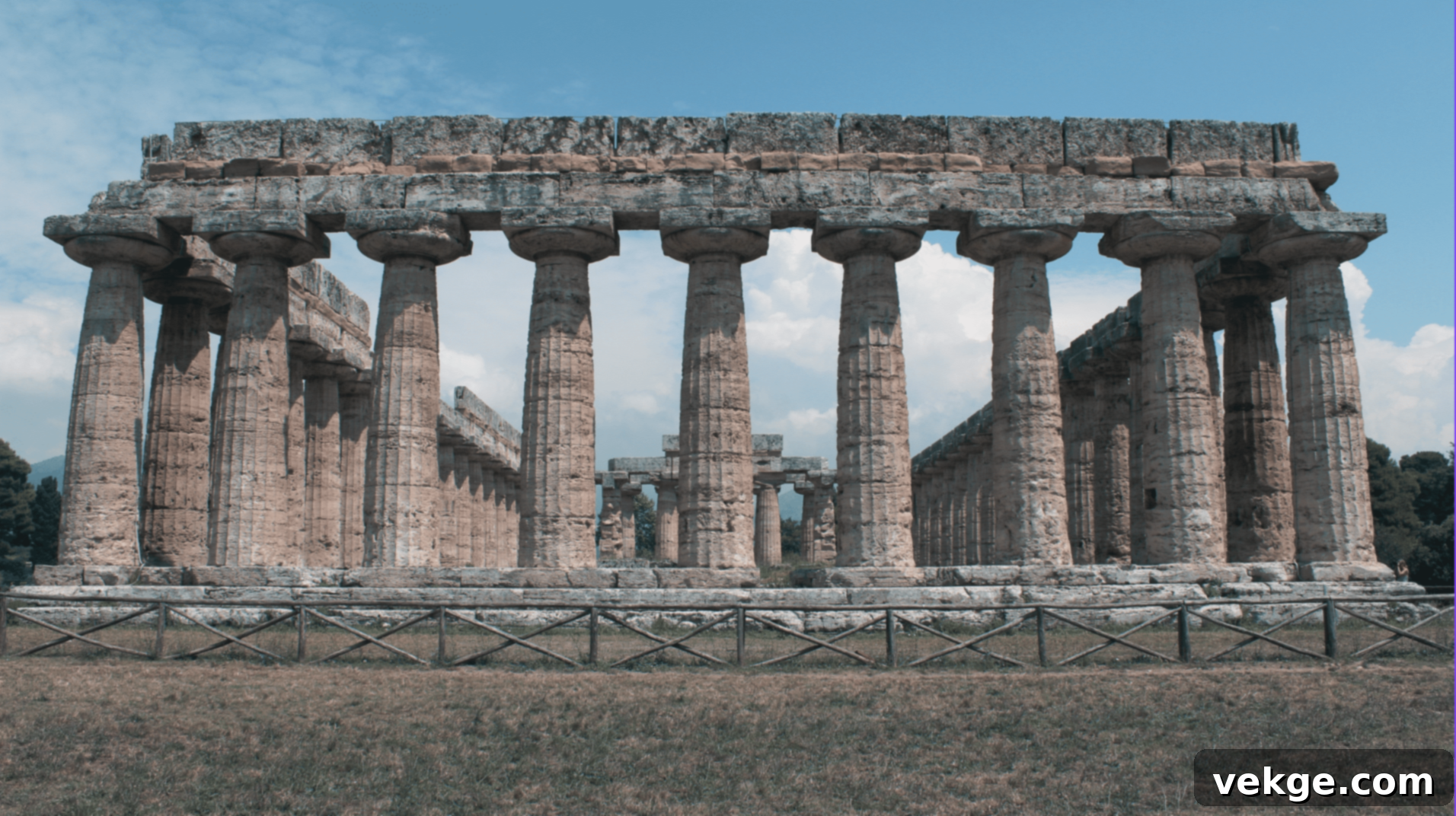
The Temple of Hera at Olympia is one of the oldest monumental temples still standing in Greece, dating back to approximately 650 BCE. It was dedicated to Hera, the wife of Zeus and queen of the gods. Uniquely, the temple originally featured wooden columns that were gradually replaced with stone ones over many centuries. This evolutionary process is evident in the remaining columns, which vary significantly in size and style, offering invaluable insights into the development of Greek architectural orders and construction techniques over time. It’s a living archaeological record of architectural transition.
11. Ancient Agora of Athens: The Heart of Democracy
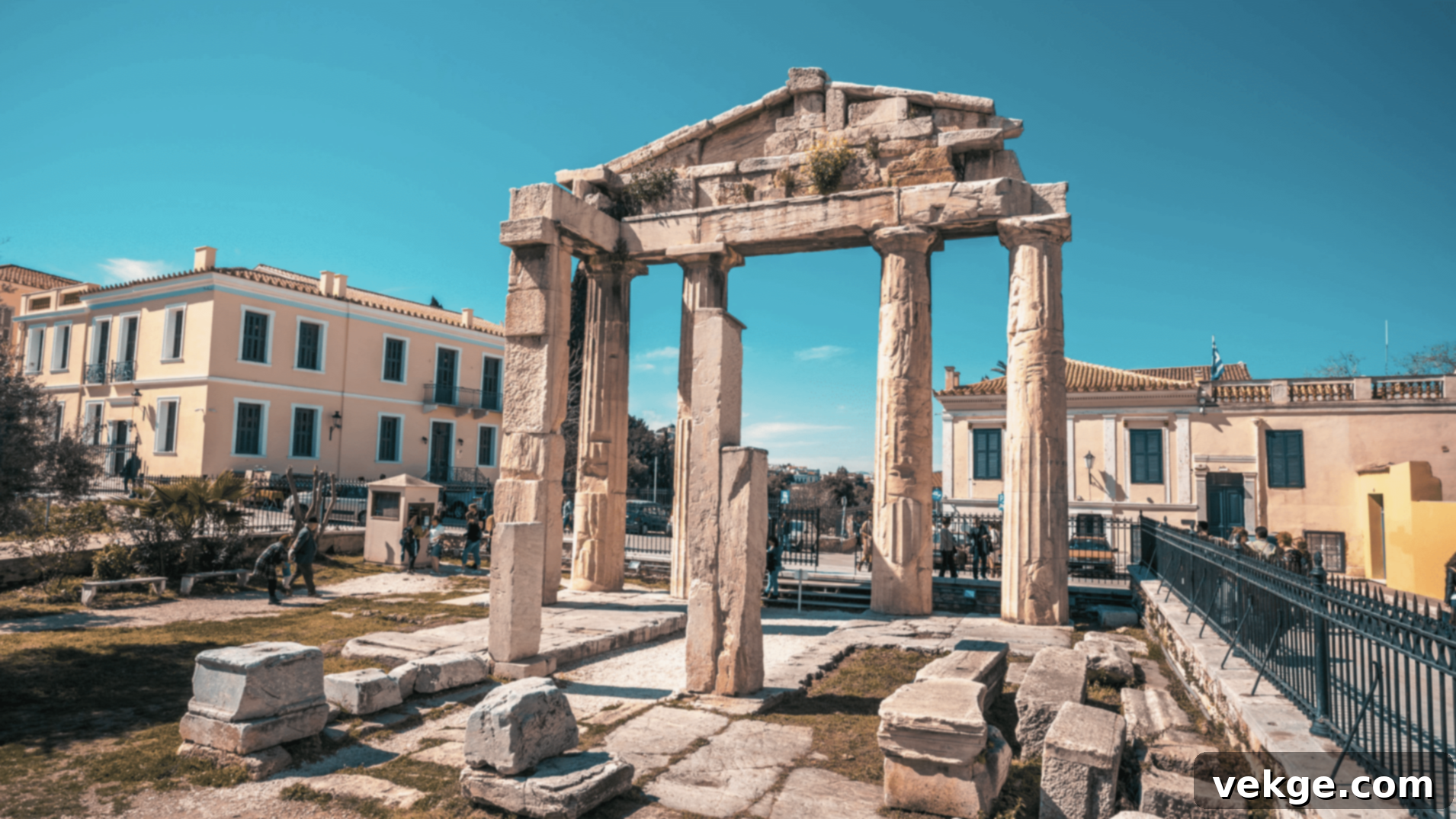
This sprawling open space was the vibrant political, commercial, religious, and social center of daily life in ancient Athens. Citizens congregated here to shop, engage in lively political debates, conduct legal proceedings, and meet friends. The area was home to numerous important public buildings, including law courts, meeting halls (like the Bouleuterion), and various temples. Walking through the Agora today offers visitors a profound and tangible sense of how ancient Athenians lived, worked, and participated in their groundbreaking democratic society, allowing one to literally walk in the footsteps of Socrates, Plato, and Pericles.
Famous Greek Theaters and Public Spaces: Engineering for Community
The ancient Greeks were masters at designing impressive spaces for both grand performances and vital public gatherings, ingeniously utilizing natural landscapes and employing clever architectural principles. These venues, often carved into hillsides, were engineered to provide not only excellent views for thousands of spectators but also superior acoustics, ensuring clear communication and a powerful, shared experience for all attendees. This intelligent design was crucial in enabling Greek leaders to effectively shape public opinion, showcase their authority, and foster a strong sense of community. By carefully controlling the built environment, they reinforced their reputation, united their citizens, and garnered support for political endeavors, including military expansion and the establishment of new territories.
12. Theatre of Dionysus: Birthplace of Western Drama

Located on the southern slope of the Acropolis hill, the Theatre of Dionysus holds immense historical significance as the very birthplace of Western drama. This magnificent open-air theater could accommodate up to 17,000 spectators who flocked to witness the timeless tragedies and comedies performed during the grand Dionysian festivals. The theater’s brilliant design, leveraging the natural slope of the hill and specific construction materials, ensured that even those seated in the uppermost rows could hear the actors clearly, a remarkable feat achieved entirely without any modern sound amplification equipment. It truly was the stage for the world’s first great playwrights.
13. Palaestra at Olympia: The Cradle of Athletic Excellence
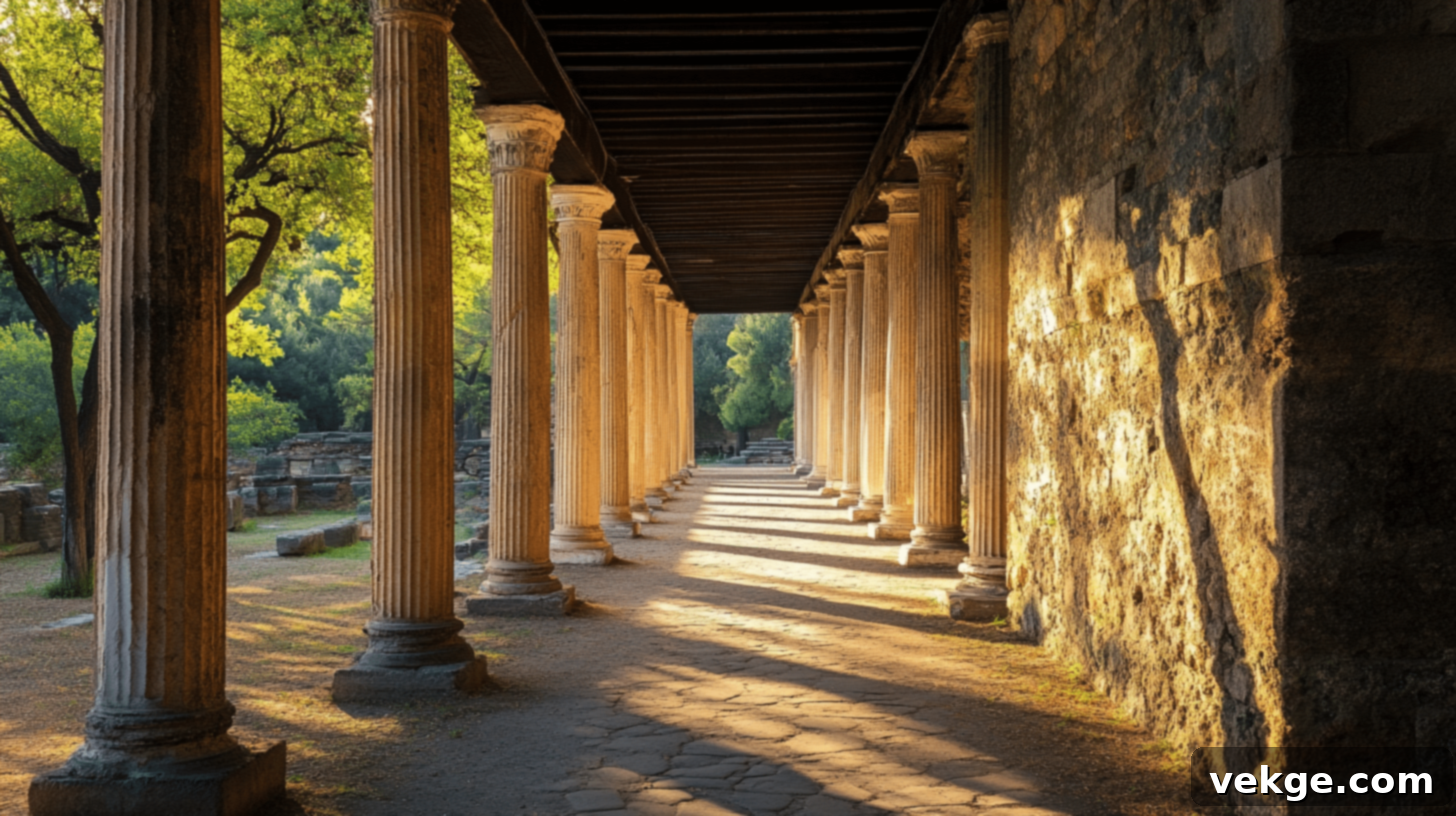
This square building, characterized by its large central courtyard, served as the dedicated training ground for athletes preparing to compete in the revered Olympic Games. The Palaestra at Olympia featured various rooms designed for intense exercise, ritual bathing, and much-needed rest. Its thoughtful layout and functional design powerfully illustrate how ancient Greeks valued both physical fitness and social interaction, as the space encouraged rigorous training and friendly conversation among the athletes. It was a place where physical prowess met philosophical discourse, embodying the Greek ideal of a sound mind in a sound body.
Noteworthy Modern Greek Buildings: Blending Past and Present
Modern Greek architecture proudly navigates a fascinating intersection of innovation and tradition, creating structures that thoughtfully acknowledge the country’s profound building history while boldly looking towards the future. Contemporary designs often subtly incorporate elements and principles from classical antiquity, reflecting a deep respect for heritage while embracing new materials, technologies, and sustainable practices.
14. The Academy of Athens: Neoclassical Grandeur
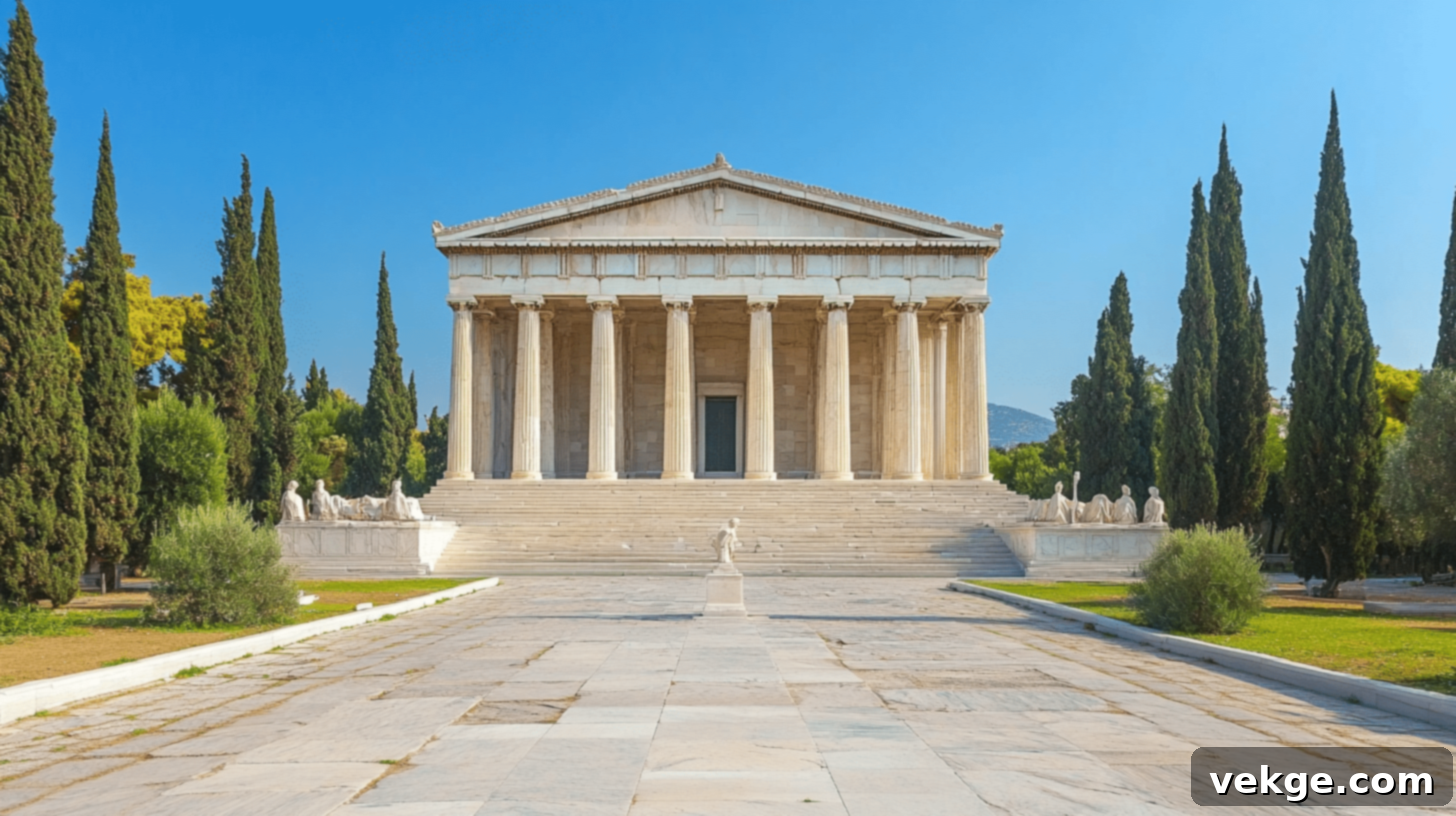
A shining example of 19th-century neoclassical architecture, the Academy of Athens, with its striking white marble and majestic tall columns, deliberately evokes the grandeur of an ancient Greek temple. This magnificent building houses Greece’s top academic institution and is adorned with impressive statues of Athena and Apollo, further emphasizing its connection to classical learning and wisdom. Its design serves as a powerful architectural statement, demonstrating how modern Greeks maintain a tangible connection with their illustrious ancient past through enduring architectural forms.
15. Stavros Niarchos Foundation Cultural Center: Sustainable Modern Icon
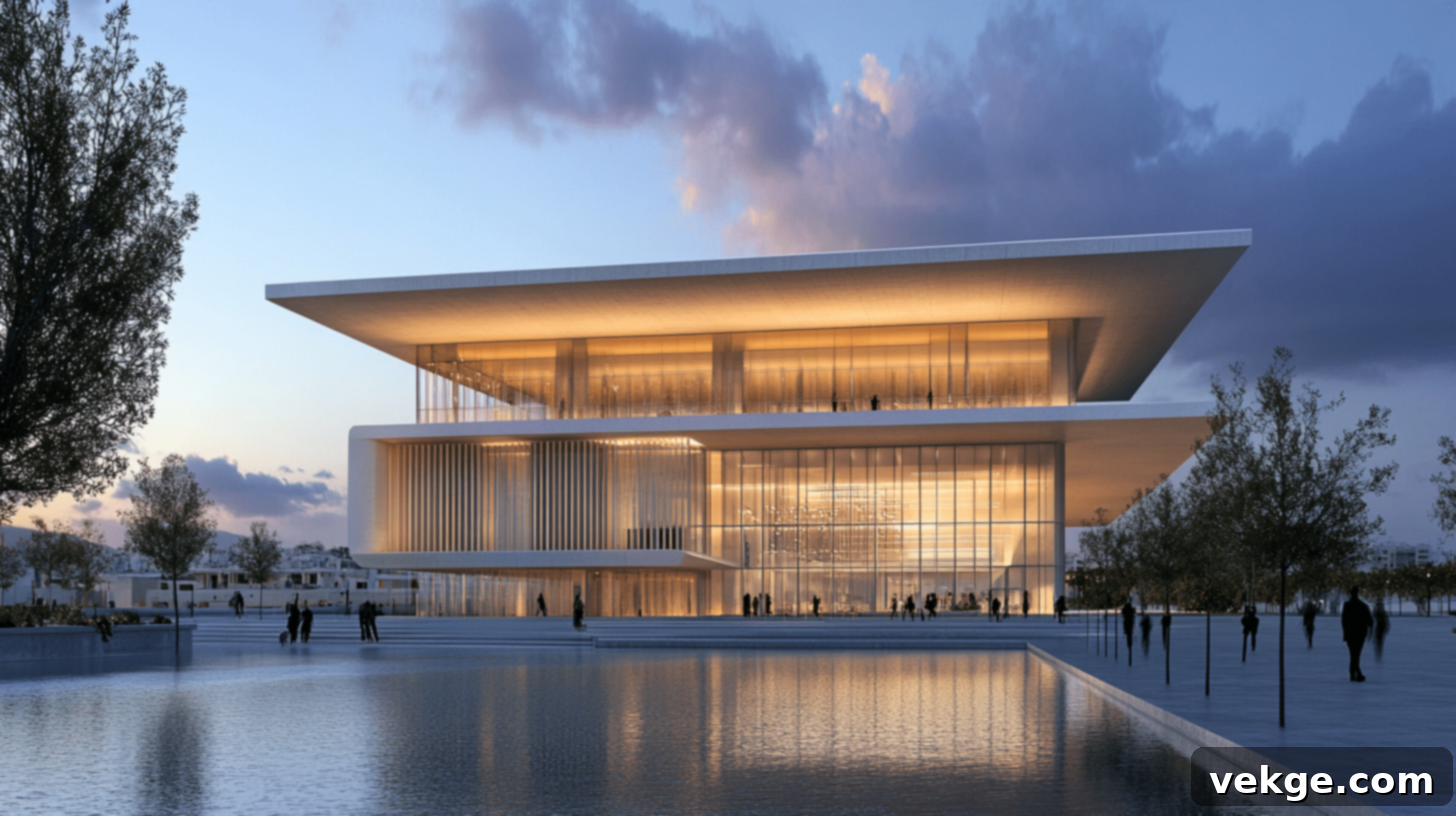
Designed by the acclaimed architect Renzo Piano, the Stavros Niarchos Foundation Cultural Center is a marvel of green-friendly contemporary architecture. This expansive complex proudly houses both the National Library of Greece and the Greek National Opera. The building intelligently utilizes abundant natural light, features an enormous solar energy roof, and is set beside an artificial hill meticulously covered with lush Mediterranean plants, creating a stunning urban park. Its clean lines, simple shapes, and harmonious integration with nature subtly echo the principles of ancient Greek temples, while fully embracing modern materials and sustainable construction methods.
16. Athens Olympic Sports Complex: A Modern Reinterpretation

Built and extensively renovated for the 2004 Olympic Games, the Athens Olympic Sports Complex is a striking collection of sports buildings, most notably featuring a main stadium crowned by an iconic roof that appears to float effortlessly above the structure. Designed by the visionary Spanish architect Santiago Calatrava, the complex masterfully employs elegant curves and expansive open spaces. This design evokes a sense of both ultra-modernity and a deep inspiration from ancient Greek ideals of harmony, balance, and athletic grace, effectively bridging millennia of architectural thought.
17. Acropolis Museum: A Dialogue with History

The acclaimed Acropolis Museum, a stunning glass and concrete edifice designed by Bernard Tschumi, is situated at the foot of the Acropolis hill and houses myriad ancient treasures recovered from the sacred site. A unique feature of the building is its transparent glass floors, which allow visitors to gaze down directly onto the archaeological ruins carefully preserved beneath their feet. The museum’s top floor is meticulously designed to match the exact dimensions and orientation of the Parthenon, creating a profound and immediate connection between the museum’s exhibits and the awe-inspiring ancient site it so respectfully celebrates.
Unique Architectural Wonders Outside Athens: Regional Diversity
Beyond the bustling capital city, Greece is home to a multitude of remarkable buildings that vividly illustrate the country’s rich, multifaceted history and the varied architectural styles that flourished across its numerous islands and diverse regions. These sites offer a broader perspective on the ingenuity and cultural expressions of different ancient Greek civilizations.
18. Palace at Knossos: Minoan Labyrinth on Crete
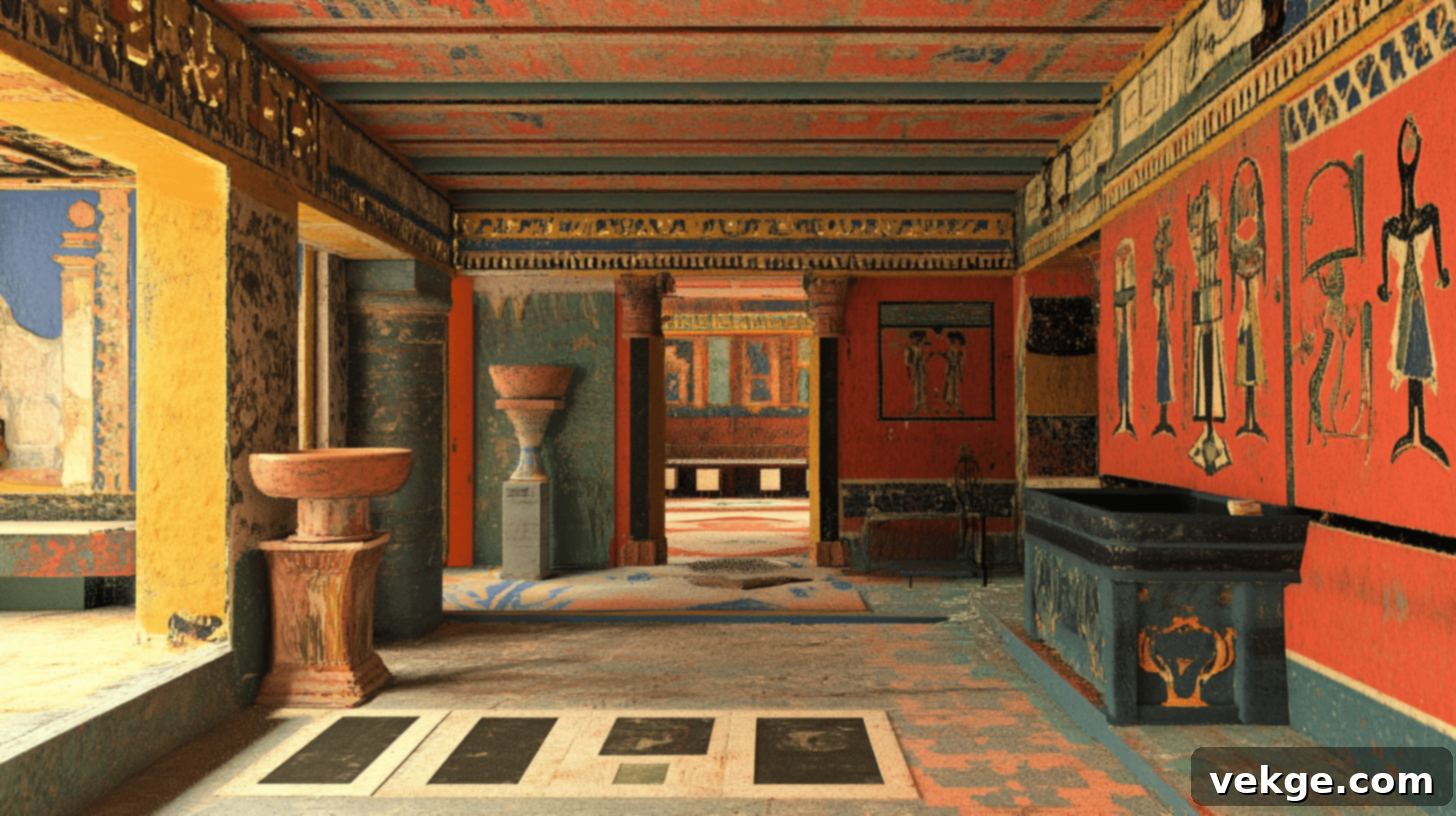
This incredibly complex and sprawling building, dating from the Minoan civilization (around 1700 BCE) on the island of Crete, featured hundreds of rooms spread across multiple levels. Its intricate layout and numerous corridors are believed by many to be the inspiration for the legendary Minotaur’s labyrinth from Greek mythology. The palace boasted surprisingly advanced features for its time, including sophisticated running water systems, effective natural ventilation, and vibrant, colorful frescoes depicting scenes of daily life and religious rituals, showcasing the extraordinary architectural and engineering skills of the ancient Minoans.
19. Asklepion of Kos: Ancient Healing Sanctuary

The Asklepion of Kos was an ancient healing center that remarkably blended medical practice with purposeful architecture to create spaces specifically designed for treating the sick and fostering recovery. Built on three ascending levels up a serene hillside, it encompassed various structures including temples dedicated to Asclepius, treatment rooms, and sleeping quarters where patients would await “incubation,” hoping for healing dreams and divine intervention. The thoughtful design of this complex powerfully illustrates how ancient Greeks believed that well-conceived buildings and a harmonious environment could actively contribute to the healing of both the body and the mind, a holistic approach to wellness.
Architectural Styles and Innovations: The Orders of Classical Greece
Ancient Greek builders didn’t merely craft beautiful structures; they developed groundbreaking design systems that profoundly shaped how buildings looked and functioned for centuries to come. One of their most enduring and impactful contributions is their systematic approach to column design, which were conceived not only for essential structural support but equally for their aesthetic style, proportion, and visual rhetoric. These distinct column styles, known as the “orders,” became the foundational vocabulary for classical architecture across the Western world and continue to influence design globally.
The Three Column Orders: Pillars of Classical Design
Greek architecture bestowed upon the world three principal column styles that fundamentally transformed the aesthetic and structural possibilities of buildings everywhere. Each of these orders possesses its own special features, historical context, and customary uses, reflecting different stages of artistic and engineering development.
The Greeks meticulously developed these distinct column orders over several centuries, with each style embodying different cultural values, regional preferences, and evolving artistic goals. Architects today still rigorously study these designs for their exceptional balance of form and function, recognizing them as benchmarks of architectural excellence and enduring beauty.
Doric: Strength and Simplicity
The simplest, most robust, and earliest of the Greek column styles, Doric columns epitomize strength, stability, and direct power. Characterized by their sturdy, almost masculine appearance, these columns have:
- No separate base; they rise directly from the stylobate (floor)
- A plain, unadorned capital (top element) consisting of a simple echinus and abacus
- Thick, strong proportions, conveying a sense of groundedness
- Minimal decorative elements, often featuring vertical fluting along the shaft
Doric columns first emerged in mainland Greece during the Archaic period and represent the earliest and most fundamental Greek architectural order. They symbolize the straightforward, practical, and powerful approach of early Greek builders. You’ll frequently find Doric columns in the oldest and most architecturally significant temples, including the world-famous Parthenon, where they convey a sense of gravitas and timeless authority.
Ionic: Elegance and Refinement
More refined, slender, and elegant compared to their Doric counterparts, Ionic columns introduce a sense of grace and sophisticated artistry to buildings. Their key distinguishing features include:
- Distinctive scroll-shaped decorations, known as volutes, prominently featured at the top of the capital
- A more slender and taller design, imparting a lighter, more graceful appearance
- A distinctive, molded base that elegantly rests on the stylobate, unlike the Doric
- Generally more intricate and decorative in their overall aesthetic, often accompanied by a continuous frieze
Ionic columns originated in the Greek cities of Ionia, located in modern-day Turkey, reflecting a more developed and ornate architectural thinking. They clearly demonstrate how Greek design evolved to become more complex, artistic, and visually appealing. These columns commonly appear in smaller, more decorative temples and significant public buildings, adding a touch of sophisticated beauty.
Corinthian: Ornate Grandeur and Decorative Artistry
The most elaborate, ornate, and decorative of the Greek column styles, Corinthian columns are truly a work of sculptural art. Their defining characteristics are:
- Extremely detailed and richly carved leaf patterns, most famously acanthus leaves, adorning the capital
- The most complex and visually stunning capital among all three orders
- A very elaborate and rich visual design, often perceived as more luxurious and grand
- Frequently employed in the most important, impressive, and often later buildings, particularly by Roman architects
Developed later than both the Doric and Ionic styles, the Corinthian order emerged in the Classical period but became particularly popular during the Hellenistic period, representing the pinnacle of Greek architectural decoration. Its opulent appearance led to its widespread adoption, especially by Roman architects who cherished its grandeur and decorative versatility for monumental structures.
The Global Impact of Greek Architecture: A Timeless Legacy
The fundamental principles and aesthetic vocabulary of Greek architecture have profoundly shaped design worldwide, exerting an enduring influence that spans millennia and crosses continents. From the neoclassical grandeur of Washington D.C.’s government buildings to the elegant facades of museums and universities across the globe, these ancient concepts continue to inspire and inform contemporary architects and designers, serving as a constant source of classical beauty and structural integrity.
A Lasting Legacy Echoed Across Civilizations
The timeless designs of ancient Greek architecture continue to inspire and inform architects worldwide, proving their enduring appeal and adaptability. From the majestic facades of grand government buildings and stately banks to the intimate details of private homes, Greek column styles and proportional systems have found their way into an incredibly diverse range of architectural spaces, including museums, cultural centers, educational institutions, and public squares. From the iconic monuments of Washington D.C. to the classical revival buildings in cities across Europe, Asia, and beyond, these classical column styles remain a powerful testament to the timeless beauty, functional efficiency, and symbolic power of ancient Greek architectural design. They are not merely historical relics but living principles that continue to shape our built environment.
Practical Visitor Information: Planning Your Greek Adventure
Planning your visit to Greece’s awe-inspiring architectural wonders requires some forethought to ensure the most enjoyable and comfortable experience. The weather significantly impacts how much you will appreciate exploring these historical sites. Many Greek ruins, especially the exposed temple complexes, offer very little natural shade, making the timing of your trip crucial for both comfort and enjoyment.
Local experts and seasoned travelers consistently recommend certain months that provide the perfect blend of agreeable weather and mercifully smaller crowds:
- Spring (April to June): Offers wonderfully comfortable temperatures, vibrant wildflowers blooming around the ancient sites, and fresh, clear air for exploration.
- Fall (September to November): Provides crisp, clear skies, pleasant warmth without the intense heat of summer, and fewer tourists, allowing for more serene contemplation.
Visiting during these shoulder seasons allows you to wander among the ancient columns and structures at a relaxed and unhurried pace. The softer, golden light during these times also creates absolutely beautiful conditions for photography and enhances your ability to appreciate the intricate details in the stonework. Avoiding the peak summer heat means you can spend more time exploring without feeling tired, overheated, or battling large crowds for the perfect view. Remember to wear comfortable walking shoes, a hat, sunscreen, and carry plenty of water to stay hydrated throughout your fascinating journey through history.
Additional Resources
- UNESCO World Heritage Sites – Greek Monuments: Explore official listings and detailed information on Greece’s protected sites.
- Book: “The Story of Architecture” by Witold Rybczynski: A highly recommended read for a broader understanding of architectural history.
We encourage you to explore these remarkable structures, whether in person or through further study, and connect with a legacy that continues to shape our world in profound and beautiful ways.
Conclusion: The Undying Spirit of Greek Architectural Genius
The monumental and elegant buildings of ancient Greece stand as powerful testaments to the extraordinary cleverness, boundless creativity, and profound engineering skills of people who lived millennia ago. The Greeks, without any modern tools, constructed awe-inspiring structures like the Parthenon – marvels of both design and construction achieved through sheer intellectual prowess, meticulous planning, and diligent hard work.
Their buildings were not only incredibly strong and aesthetically beautiful but also ingeniously designed with smart optical tricks, such as the subtle curvature of columns to make them appear perfectly straight. These ancient monuments continue to inspire architects, artists, and thinkers across the globe today. When you stand before them, or even simply gaze upon their images, you can’t help but ponder: “How did they achieve such perfection?” and “What invaluable lessons can we still glean from their ingenuity?”
The most exhilarating aspect is that many of these incredible sites are accessible, allowing you to physically visit and walk where ancient Greeks walked, touch the very stones they touched, and breathe the same air that inspired their greatest achievements. This immersive experience makes history feel tangible, alive, and incredibly real. Perhaps these magnificent buildings will spark new ideas and ignite your own creative spirit. After all, every great builder, artist, and innovator draws inspiration from the enduring masterpieces of those who came before them. The legacy of Greek architecture is a constant invitation to look, learn, and create anew.
